This post may contain affiliate links, please view our disclosure policy for more details.
Like most new parents, you might be super anxious and scared when your baby starts gagging for the first time. We get it!
It can look very scary and be hard to watch before getting some experience and insight into how gagging works.
Questions we get from parents all the time include:
-
Is gagging normal for babies?
-
How do I know if my baby gags too much?
-
How do I progress in textures when my baby gags so much?
-
How do I help decrease my baby's gagging?
-
When will my baby’s gag reflex disappear?
You’re not alone, and we’re here to help you get through this stage with your little one and give you the confidence to handle your baby gagging like a pro. Let’s go over everything you need to know!
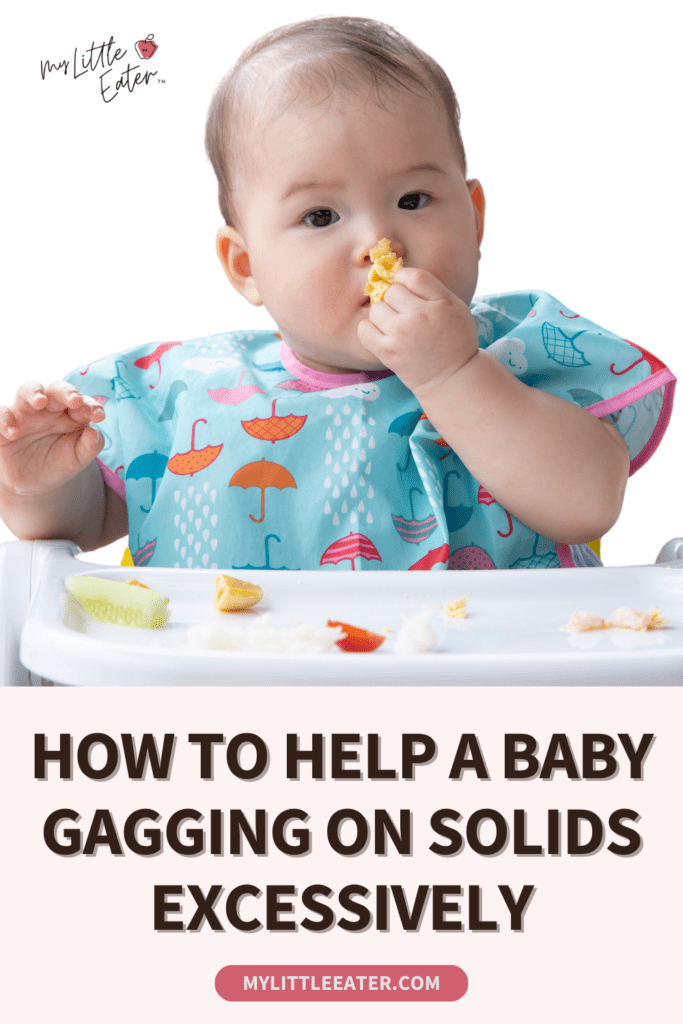
Table of Contents
Gagging is a normal part of starting solids. We expect it to happen and want to prepare you because you will be seeing a lot of gagging in the initial stages of introducing solid foods.
But how can you tell if your baby is gagging excessively and how can you help them overcome it if they are?
Before we tackle all of these topics, let’s first understand gagging and how to not react in these situations (this is super important). We will be focussing primarily on normal gagging vs excessive gagging for this article.
If you aren’t sure of the difference between gagging and choking (because they’re very different) you can learn more about that in our blog on identifying gagging vs. choking.
If you’re feeling stressed or scared about introducing more textured foods and finger foods, register for our free workshop, “Baby Led Weaning…but make it purées!”
You’ll learn all about gradually moving from easier to more advanced textures while overcoming fears about gagging and choking.
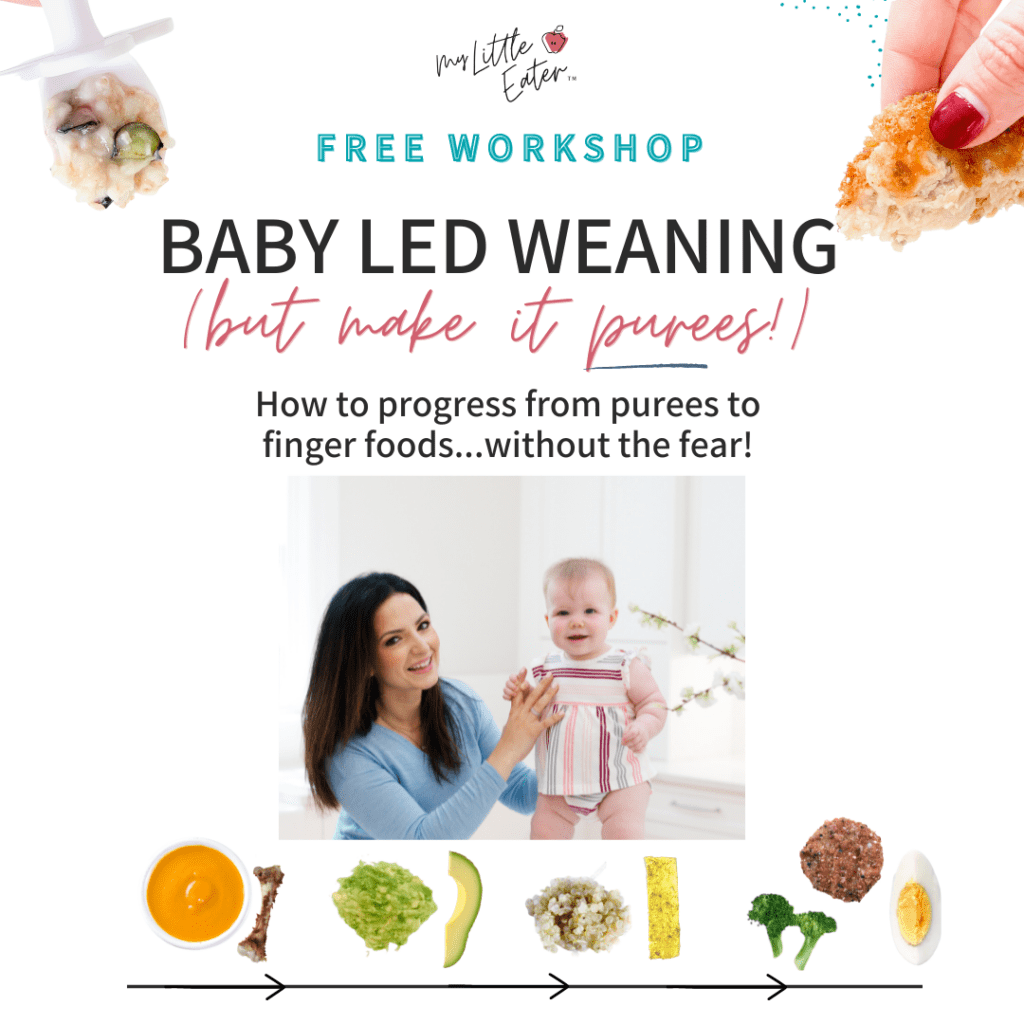
Why an infant gagging while eating is normal
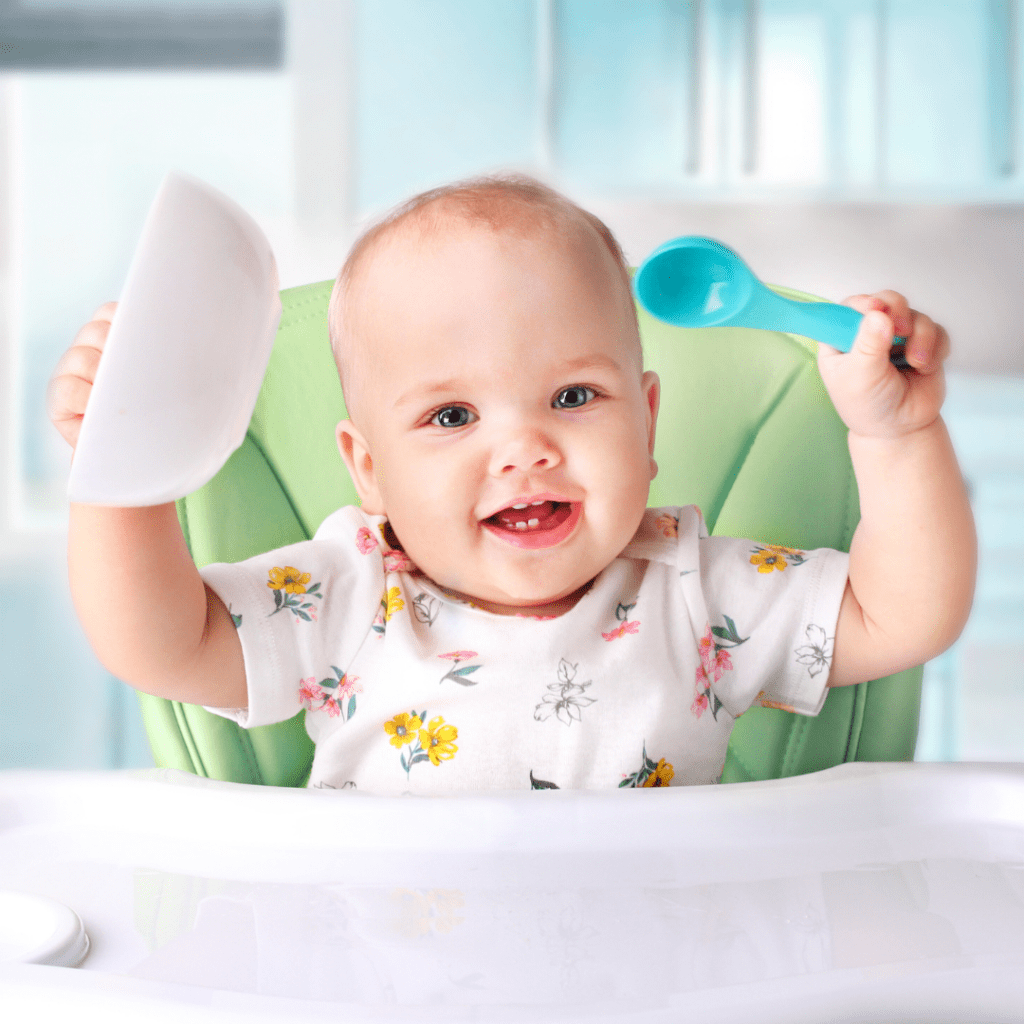
The gag reflex is a normal and natural protective reflex to help your baby as they learn how to chew and swallow solid foods, whether that’s purées or finger foods. In essence, it’s the opposite motion of a swallow.
When your baby is learning how to eat, the gag reflex is supposed to kick in to help your baby keep food in an area of their mouth that makes it more manageable to chew properly (or spit out).
We know it can be hard to watch, but it really is okay to see your baby gagging. It doesn’t mean there’s something wrong with your baby, it doesn’t mean they’re struggling, and it doesn’t necessarily mean they shouldn’t be having food of that texture. It just means that their body is doing its job in keeping your baby safe as they’re learning how to eat (1).
The hardest part about watching your baby gag is that you can’t and shouldn’t do anything about it (1). You must let your baby work through the gag on their own.
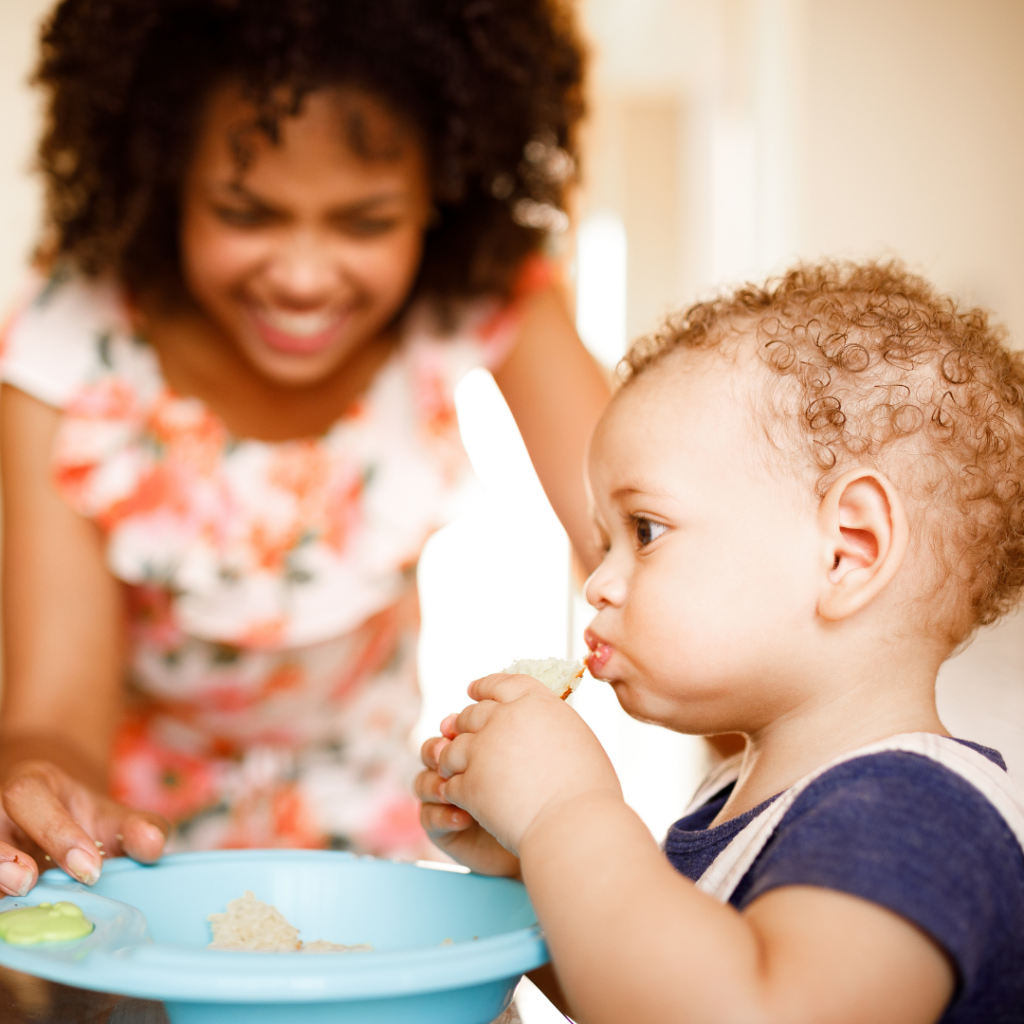
Most babies are generally unphased by gagging and will keep eating after it passes. If your baby gags and you start to act scared and frantic, they might think they should be frantic too. This can create negative associations with mealtime or specific foods.
We want their natural response reflex (gagging) to do its thing here. Let them stay calm while it happens, and you’ll see they’ll work through the gag and be completely fine.
We understand that even after reading this blog you may still be TERRIFIED when your baby starts gagging. It can be so scary and stressful, especially for the first few times.
If you’re scared and want a step-by-step approach so you can gradually ease into offering more difficult textures, sign up for our FREE workshop on how to transition from purées to finger foods (without the fear).
How much gagging is normal in baby led weaning?
Different babies gag on different foods, at different times, and throughout different points in the starting solids journey. Gagging is considered to be perfectly normal (on both purees and finger foods). It’s harmless if your baby can continue their meal without discomfort and go back for more food (if they’re still hungry).
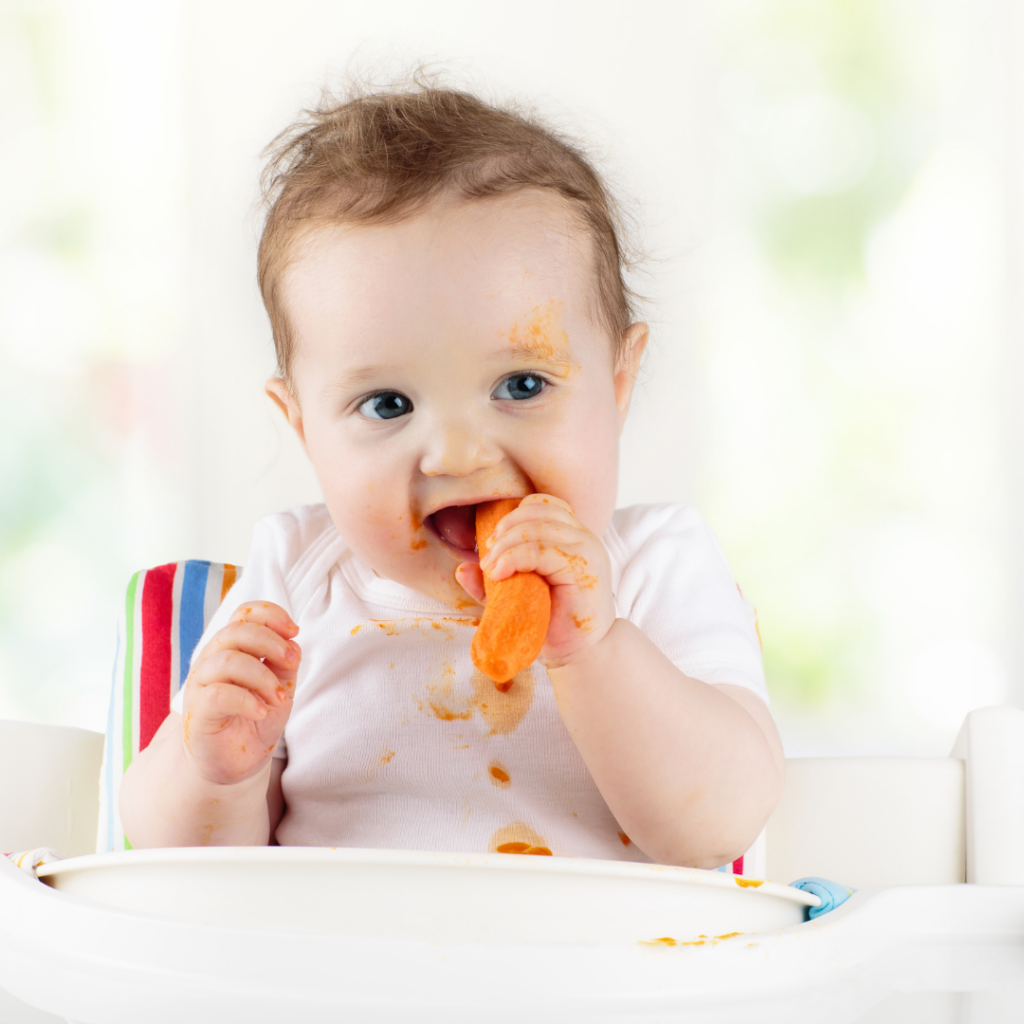
For the most part, babies gag more in the first few months of starting solids (between 6-9 months of age). This is because the gag reflex is the most sensitive during this time.
The gag reflex starts off being easily triggered when food is at the front third of the tongue (2). When something touches this area or goes slightly past it, they’ll likely start gagging.
This is actually a good thing!
It allows babies to practice with food in their mouth and learn to chew, all while being extra protected by their sensitive gag reflex. This also means it will be safer for babies to experience more advanced textures during this time (6 to 9 months) since they have this extra protective mechanism in place.
As you allow your baby to become accustomed to having food of different types in their mouth, the gag reflex moves slowly towards the back two-thirds of the tongue (2). This makes sense, as your baby will have had much more practice and will not need to be so heavily protected with an extra sensitive gag reflex (1).
Is baby gagging and vomiting on solids normal?
Infrequent vomiting induced by gagging is normal for babies. For some babies, gagging can be a bit more forceful, and as they push food forward to the front of their mouth, they may do it with enough force that they vomit a little.
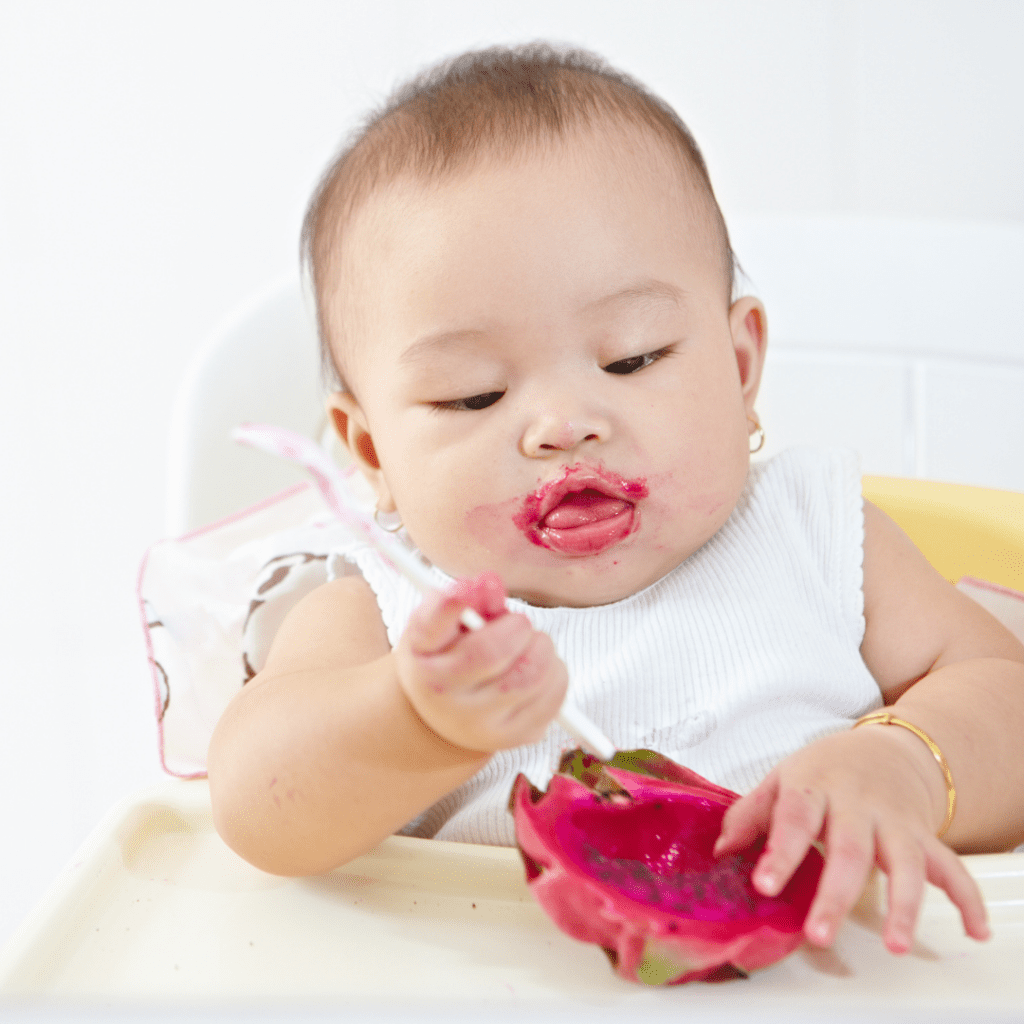
All babies are different and some have a more sensitive gag reflex than others. So not all babies will experience this, or you may notice that they do it more often when new foods and textures are being introduced.
To decrease the likelihood of vomiting from a gag, make sure your baby doesn’t have a full belly from breast milk or formula when you offer solids. That’s because this can make a forceful gag more likely to turn into vomiting if they haven’t had enough time to digest after nursing or bottle feeding.
Also, giving your baby lots of practice with long, resistive finger foods or teethers (away from meal time) will help them work towards diminishing that sensitive gag reflex. Practicing in this way will help vomiting with gagging to become less frequent.
Essentially, if your baby is experiencing occasional vomiting with a specific texture, this is ok! Just make sure you keep practicing with that same texture for at least a couple more days, or even a few more weeks, to give them more time to get accustomed to it before moving on.
When vomiting solid foods may be a concern
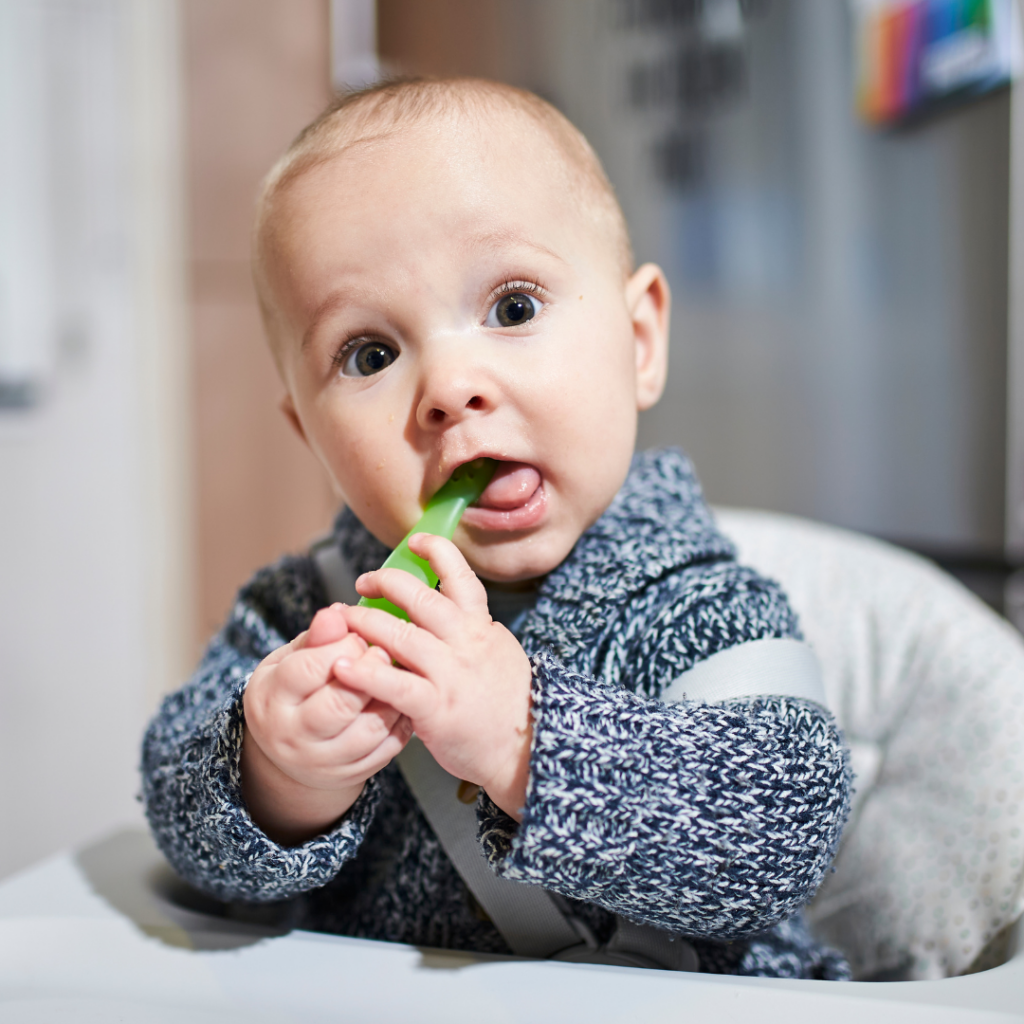
There are some red flags with vomiting to look out for that may indicate something more serious is going on.
You want to specifically pay attention to…
- The frequency of your baby’s vomiting
- And your baby’s behavior following a vomiting episode
Vomiting shouldn’t be so frequent that it happens at most meals, or always with specific textures despite weeks of practice with that texture.
Vomiting also shouldn’t cause mealtime to be a traumatic or a negative experience for your baby. If it’s causing your baby to be agitated at mealtime, we strongly recommend seeking help from a feeding therapist.
Vomiting and food allergies
It’s also important to know that vomiting shortly after a meal can be a sign of an allergic reaction and/or FPIES. FPIES is a type of food allergy that can cause repetitive vomiting, diarrhea, and dehydration (4).
FPIES reactions are triggered by eating a particular food. The most common foods include soy and dairy products, grains (rice, barley, oats), chicken, turkey, and fish (4).
A reaction might not be so obvious, since vomiting may not occur until several hours after the triggering food is eaten. If you do suspect your child has symptoms of FPIES, see an allergist for diagnosis and treatment.
Does gagging on solid foods stop on its own?
No, gagging won’t necessarily go away on its own.
However, most babies usually outgrow gagging after a few months of practice with solid foods, finger foods, and a variety of different textures. Every baby is different and when gagging decreases depends on the frequency with which they eat solids and the variety of textured foods being offered.
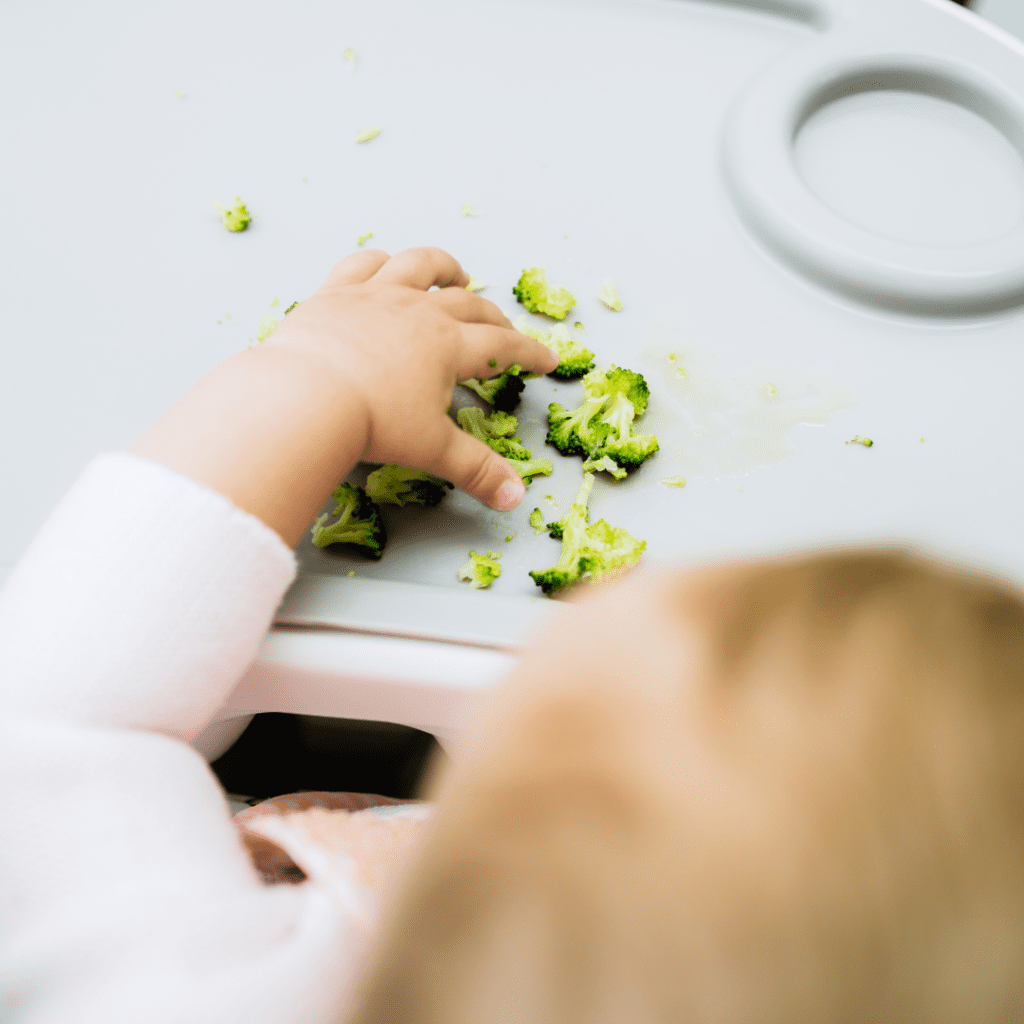
Babies who weren’t introduced to textured foods and given ample opportunities to gag in the beginning, between 6 to 9 months of age, will most likely still gag as older babies. They may even experience increased gagging because they’re SO used to purées at that point that new textures, even soft foods, will be extremely difficult for them to manage.
If you’ve been offering purées for some time and don’t see any gagging, or only notice it occasionally, your baby has mastered the texture of purées. This means they’re ready to move on and explore more advanced textures.
It’s not beneficial to keep offering only puréed foods once your baby has mastered this texture.
Learn more about why you need to start your baby on textured finger foods ASAP.

Similarly, we also hear from parents who hope that by delaying the introduction of finger foods their baby will experience fewer gags when they finally do introduce them. Unfortunately, this can backfire and result in more gagging because they missed that critical practice early on, as mentioned above.
We want to use the time between 6-9 months (also known as the critical period) for babies to explore as much table food as possible, advance in textures, and build on their oral motor skills (aka the skills required to chew and eat and swallow) (2, 3). Doing that while their gag reflex is nice and sensitive is safer as it works to prevent choking (2, 3).
Check out our blog on why food before one is not just for fun, to learn more about the importance of introducing solids at the right time.
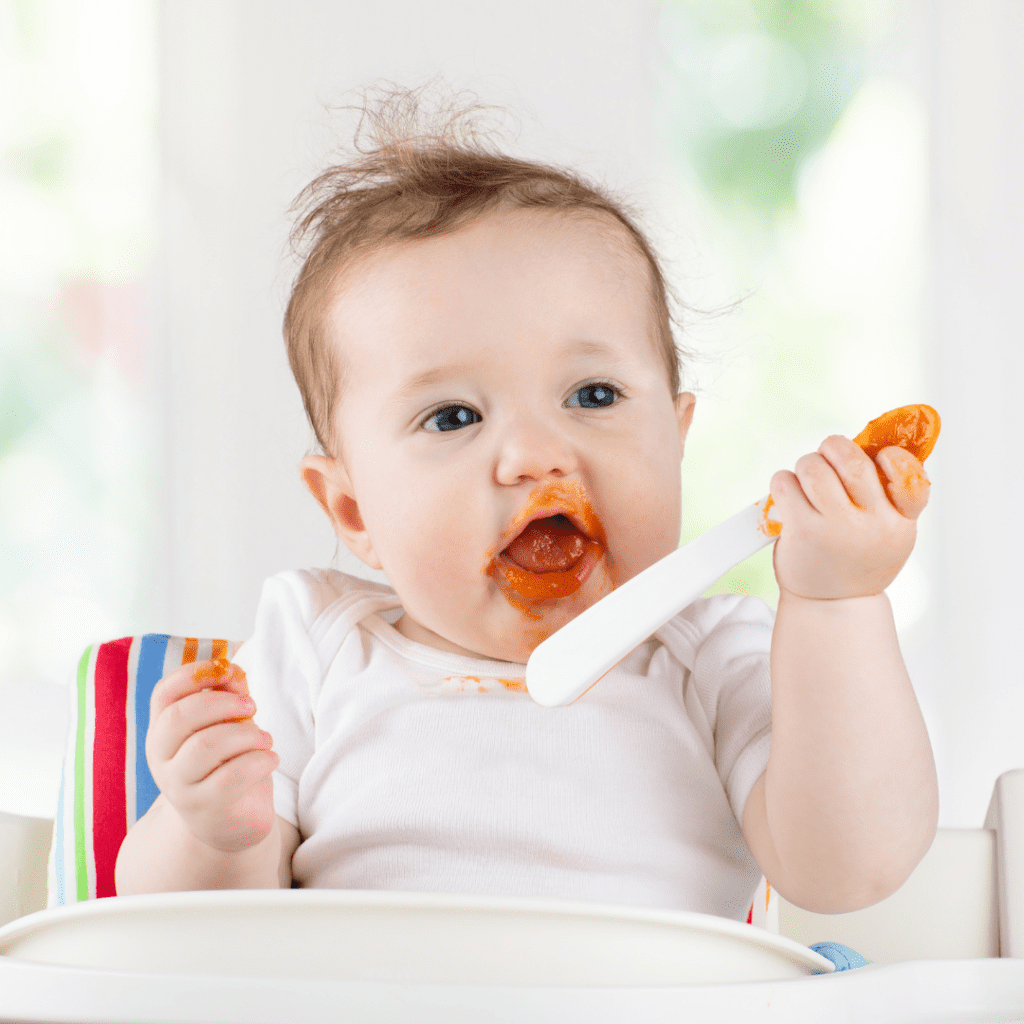
Overall, be patient. It will take time and consistency for your little one to master all of these new textures.
As your baby continues to eat solid foods, you’ll notice their gag reflex become less sensitive over time, though it will never disappear completely. The more frequent gagging you may observe in the first few weeks or months will come to an end and you’ll only notice your baby gag on rare occasions.
If you’re feeling stressed or scared about introducing more textured finger foods – register for our FREE workshop!
You’ll learn all about gradually moving from easier to more advanced textures while overcoming fears about gagging and choking.
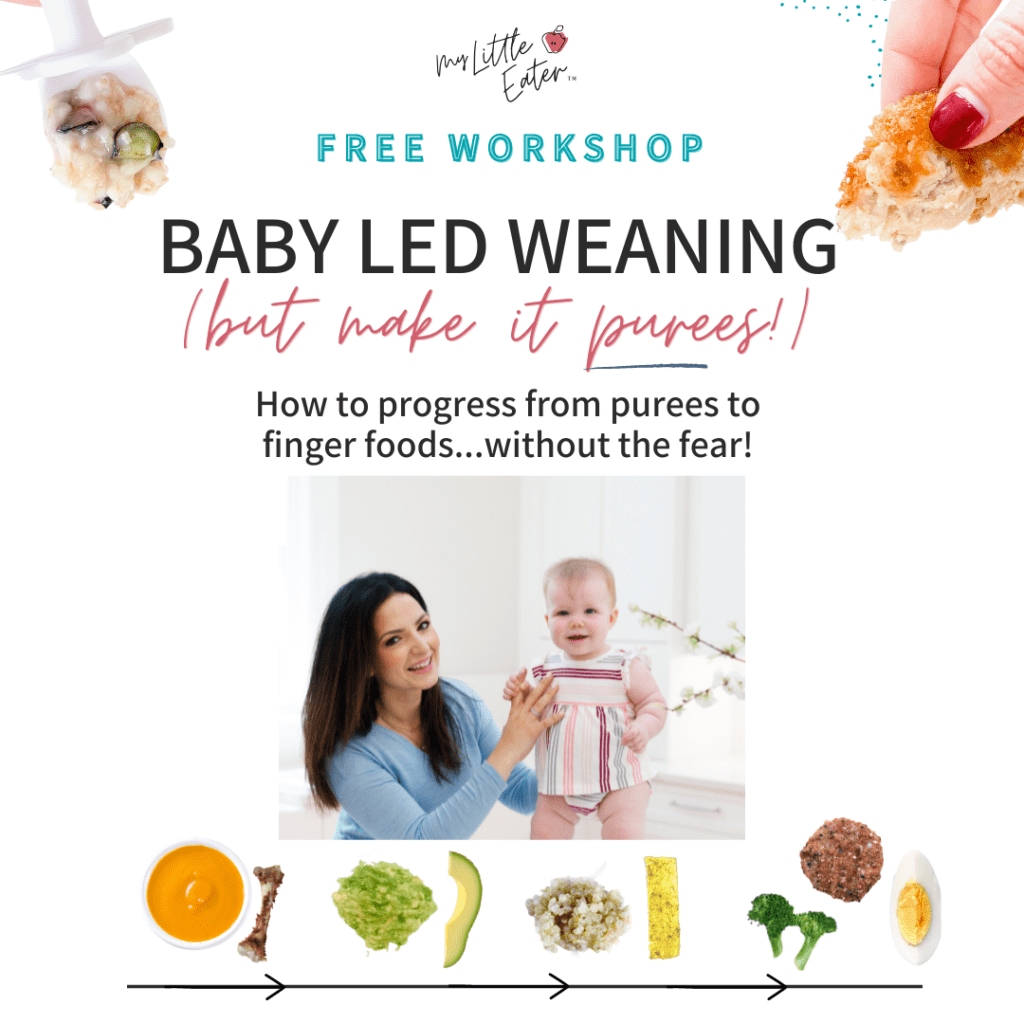
When to seek help for an infant gagging while eating
Now that you know that babies gag a lot when they first start solids, it’s important to be able to recognize when your baby is gagging more than normal.
Gagging is not something that should be holding your baby back from eating. If your baby is gagging excessively throughout every meal on one specific texture, you may need to go back to an easier texture. This allows them to keep practicing and master that texture before moving on again or seeking help.
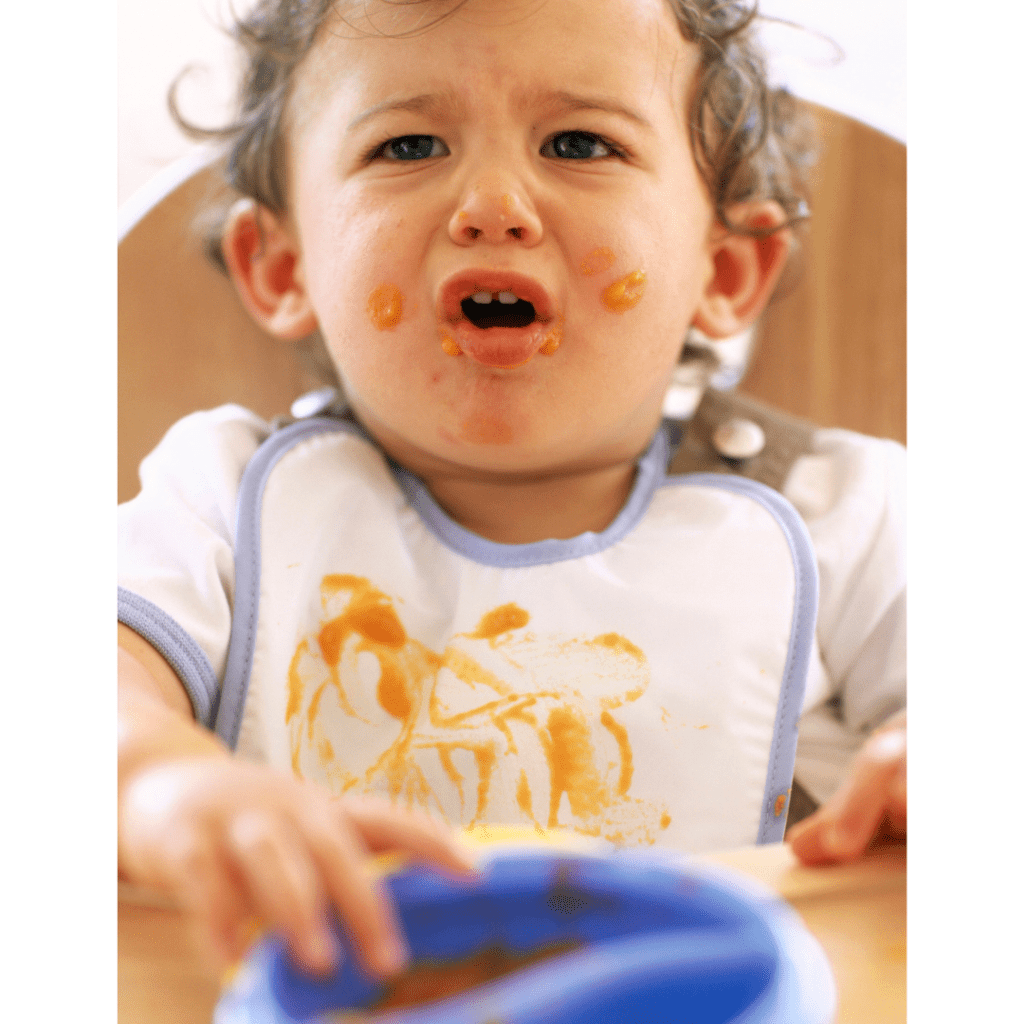
Some red flags to watch for include:
- Your baby continuously gags at most meals even after 2 months of daily practice with a variety of advanced textures and finger foods (or if they’re past 9 months of age).
- Your baby becomes upset after gagging and doesn’t want to continue eating (crying, tantrums, food refusal).
- Your baby continues to vomit with gagging at most meals even with an empty belly.
If you see any of these red flags, seek help from your doctor and ask for a referral for a feeding evaluation to rule out any medical or sensory issues. This is especially true if your baby gags at the sight or touch of food.
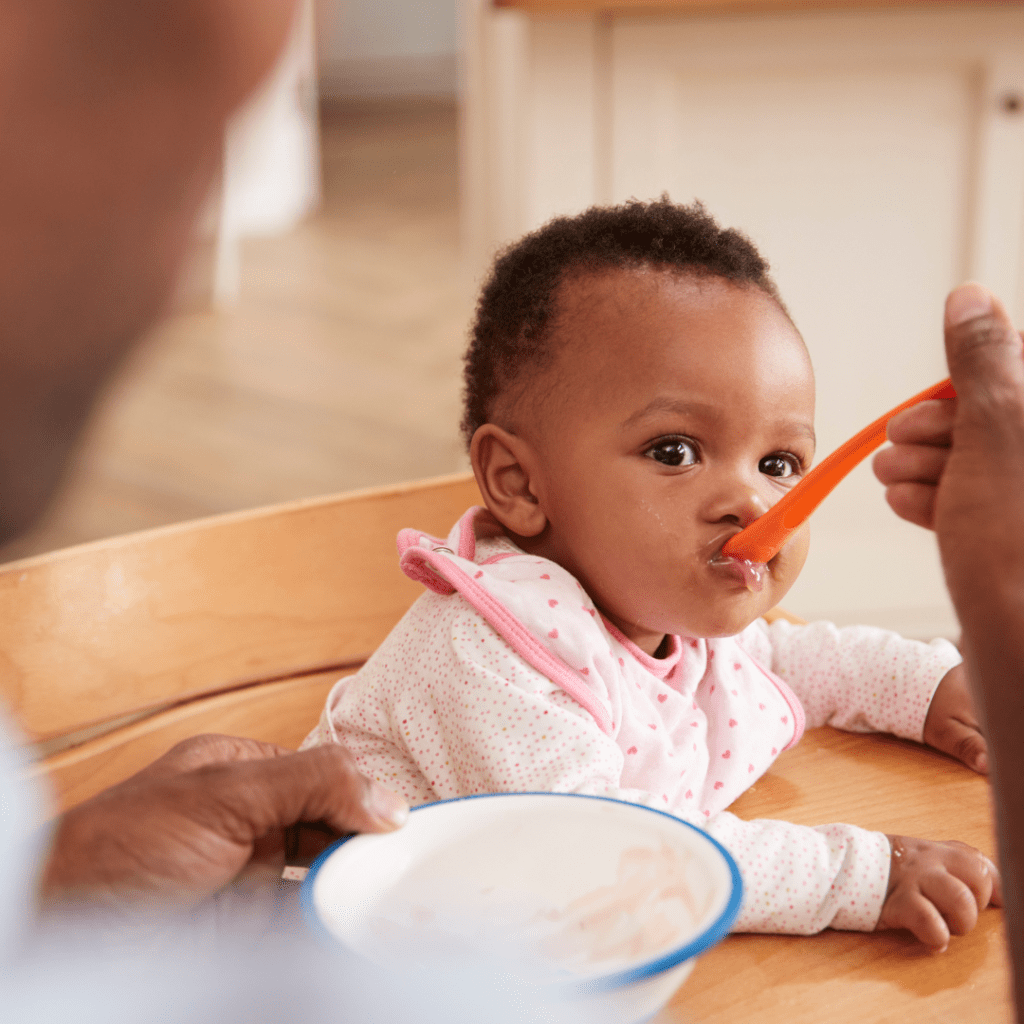
However, if your baby is gagging minimally, going back to offering only smooth, puréed foods and hoping that feeding will improve naturally as they get older, doesn’t always work (as mentioned above).
Most kids with very sensitive gag reflexes need to experience the feeling of texture in their mouth to make their gag reflex less sensitive.
How to diminish your baby's gag reflex
Offer long teethers during play
To help your baby overcome their sensitive gag reflex, you can offer long safe objects your baby can mouth until you start to see a decrease in the frequency of gagging. Offer these either during playtime or during meals!
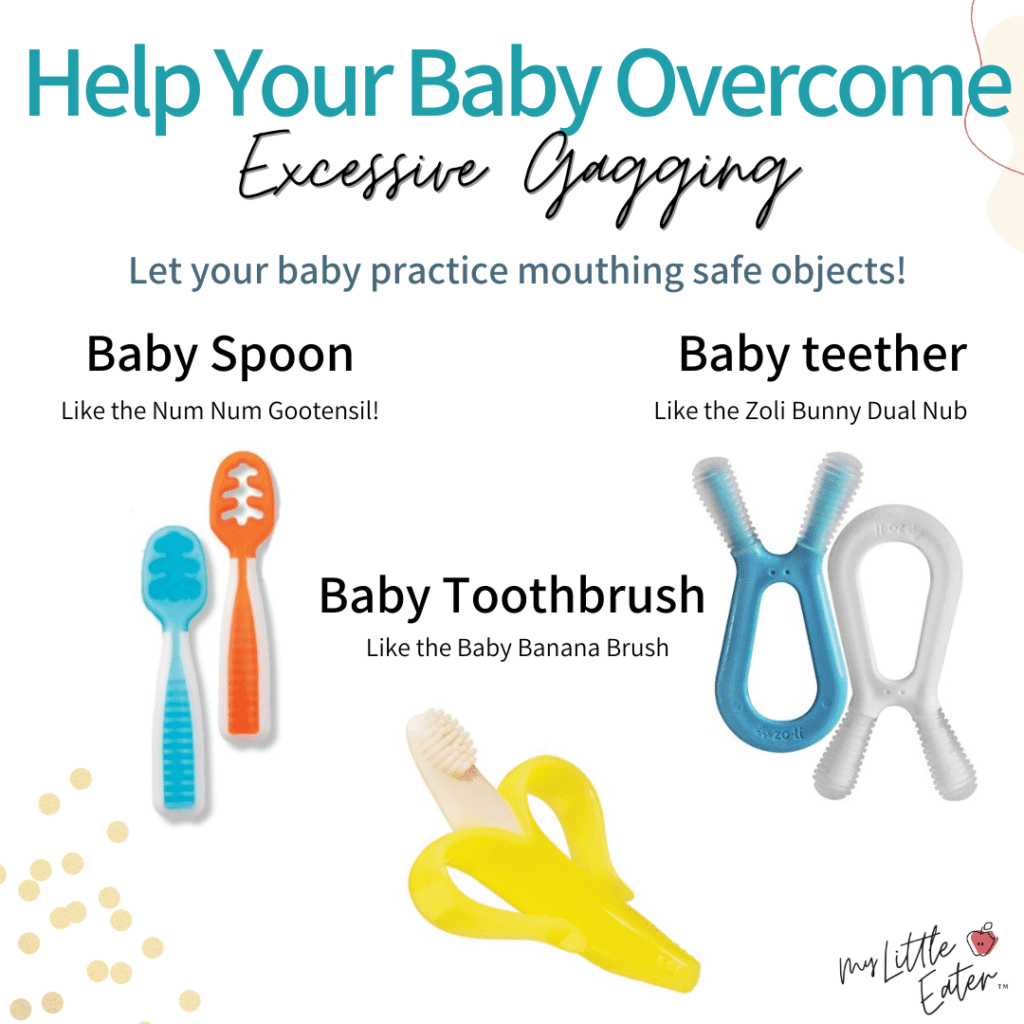
Long-shaped teethers, baby spoons, and baby toothbrushes are perfect! Allowing your baby to experience placing these objects far back, and in different areas of your baby’s mouth, helps desensitize that gag reflex and pushes it further back in the mouth.
Allow baby to self-feed
Children with sensitive gags often do better when self-feeding, so allow them to feed themselves for all or part of the meal.
Self-feeding ensures they have complete control over the finger food or spoon, so they can anticipate the movements of the utensil and food better in their mouth. They can control how far in their mouth they place a spoon or finger food, easing it in so as not to unnecessarily trigger a gag reflex. This keeps it more comfortable for them and overall a much less stressful experience.
On the other hand, when another person feeds them, it can be hard to know where food will land in their mouth, and since baby can’t predict it as easily, it can cause more gagging. Your baby is also unable to move the spoon or remove it based on what they need because someone else is in control.
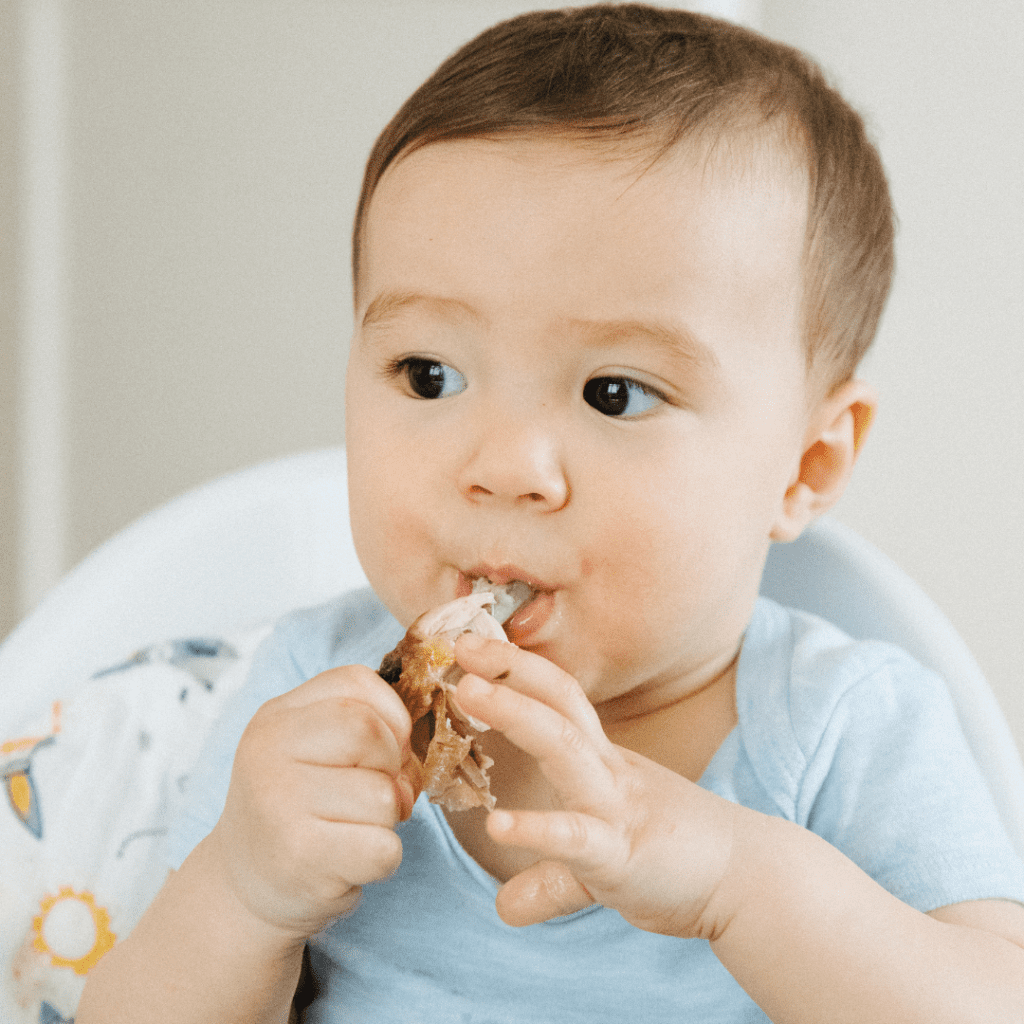
Remember that gagging provides feedback to your baby, which is how they learn about manipulating food safely in their mouth. If they receive this feedback but don’t have control over how they’re eating, the feedback isn’t nearly as helpful to help prevent unnecessary gagging next time.
Serve hard, resistive whole foods
During meals, offer your baby big pieces of food they can use for moving around in their mouth and safely exploring the boundaries of their mouth. These foods should be hard, resistive foods with a low risk of baby choking, like a chicken drumstick bone, mango pit, or a thick watermelon rind.
Note: This is only a safe option if your baby does not have teeth and isn’t able to bite through the food being offered.
Provide more frequent practice eating solid foods
Offering solids consistently every day is very important for allowing your baby to practice eating foods. It also helps to desensitize the gag reflex more quickly than if they don’t receive daily practice.
If you notice your baby seems to be having difficulty with gagging or isn’t showing much interest in food, you can increase the number of times they’re eating per day.
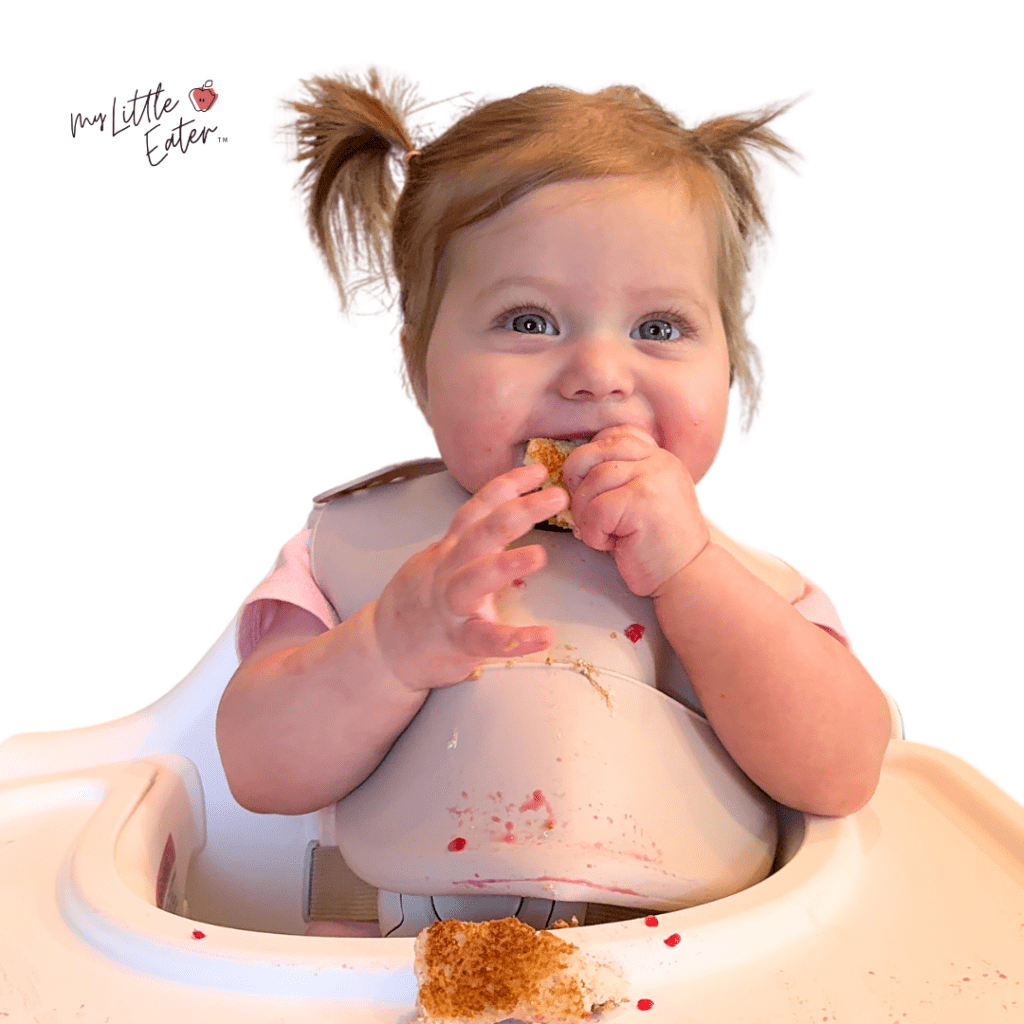
We want to make sure that solids aren’t displacing too much breast milk or formula, especially in the beginning. Be mindful that they’re meeting their minimum requirements for milk daily based on their age. Refer to our sample feeding schedules for information on what those requirements are.
That said, keep in mind that it’s easy to adjust meals by decreasing the number offered if you increase them and it affects milk intake, but you can’t go back in time and offer more opportunities to practice eating during the critical window of 6-9 months.
The bottom line – and as a Speech Language Pathologist we’ve worked with says – the only way that babies learn how to eat food…is to eat food! We need to give them opportunities to eat food and for gagging to get better.
The best way for babies to learn this new skill (yes, eating is a skill!) is to offer them a wide variety of foods with different textures and flavors to give them lots of practice and opportunities to explore.
The more exposure and practice they have with each texture, the more confident they’ll be with the next, more advanced texture. And before you know it, they’ll be confidently eating all of these new textures like a pro!
If that all sounds too good to be true, maybe you’re feeling a bit stuck on purees, or scared about offering finger foods – check out our free workshop “Baby Led Weaning… but make it purées!”.
We’ll show you our signature approach to starting solids, with either purees or finger foods, walk you through it step-by-step, and put all your concerns about gagging and choking to rest!
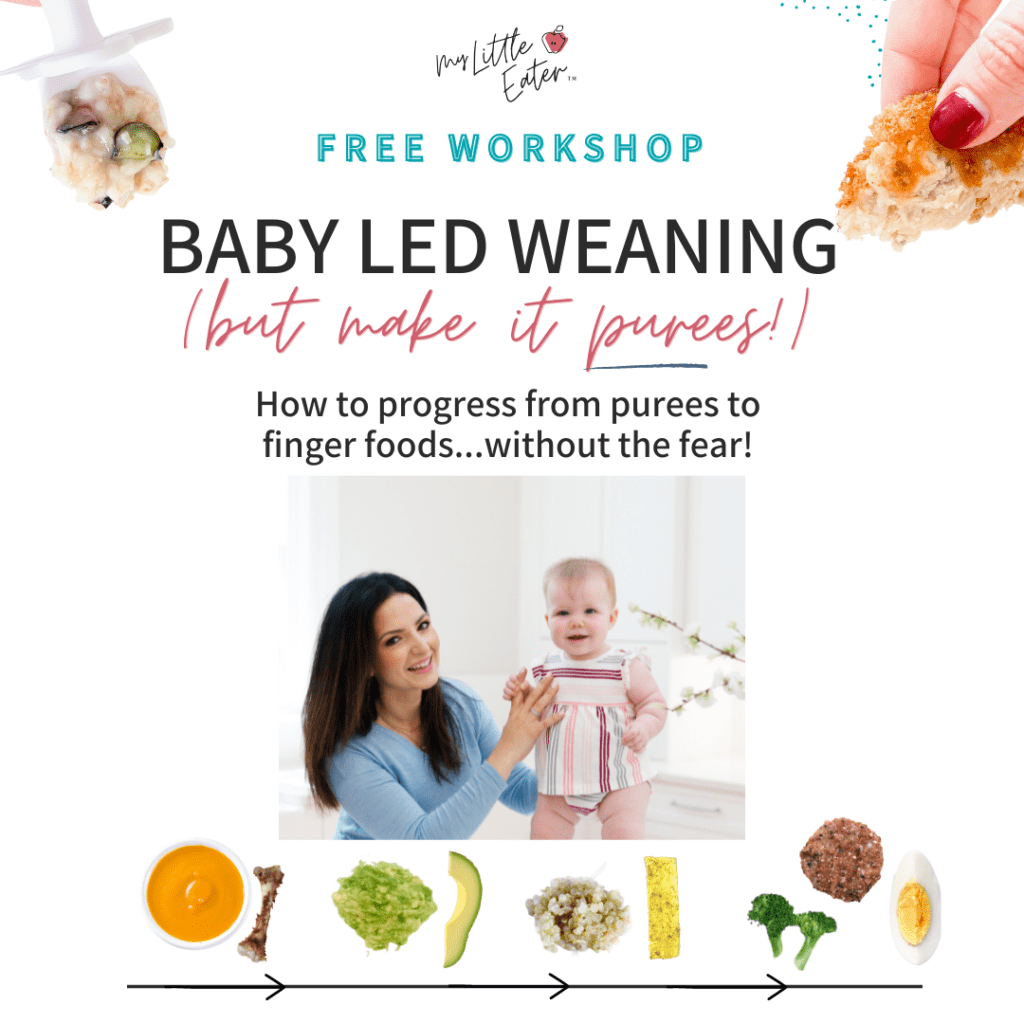
Did you find this helpful? Pin it to save for later!
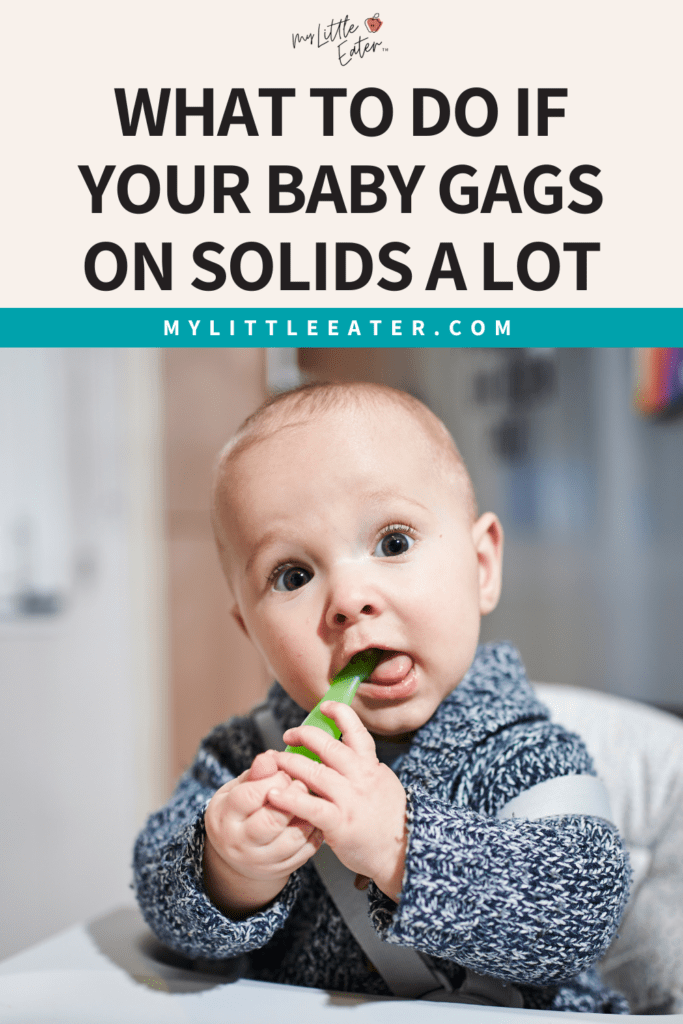
References
- Rapley, G., & Murkett, T. Baby-Led Weaning, Completely Updated and Expanded Tenth Anniversary Edition: The Essential Guide—How to Introduce Solid Foods and Help Your Baby to Grow Up a Happy and Confident Eater. The Experiment (2019).
- Naylor, A. J., & Marrow, A. L. (2001). Infant Oral Motor Development in Relation to the Duration of Exclusive Breastfeeding. Developmental Readiness of Normal Full Term Infants to Progress from Exclusive Breastfeeding to the Introduction of Complementary Foods, 21–25.
- Coulthard, H., Harris, G., & Emmett, P. Delayed introduction of lumpy foods to children during the complementary feeding period affects child’s food acceptance and feeding at 7 years of age. Maternal & child nutrition, 5(1), 75-85 (2009).
- The American College of Allergy, Asthma, & Immunology. https://acaai.org/allergies/allergic-conditions/food/food-protein-induced-enterocolitis-syndrome-fpies/

Chelsey Landry, RD
Community Dietitian at My Little Eater Inc., and bunny-mom to Hickory. Chelsey offers one-on-one counselling to parents of babies and toddlers that need more customized support. Learn more by booking a free discovery call with her today!

Chelsey Landry, RD
Community Dietitian at My Little Eater Inc., and bunny-mom to Hickory. Chelsey offers one-on-one counselling to parents of babies and toddlers that need more customized support. Learn more by booking a free discovery call with her today!









